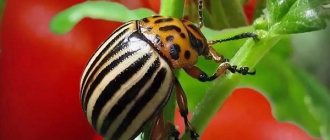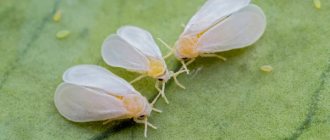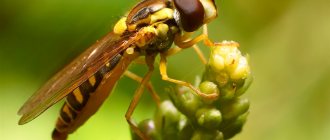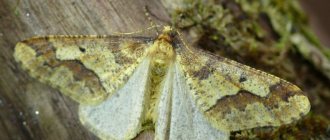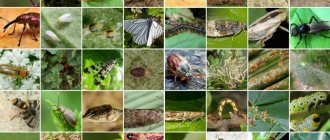Large and sweet carrots are the dream of every vegetable grower. But thanks to its sweetness and specific smell, many insects love it. Since carrots are a root crop, they are often damaged by soil pests, resulting in reduced crop size and quality. Aphids, cutworms and psyllids can also worsen the condition of plants.
How to recognize carrot pests, as well as how to deal with them using prevention, folk, biological and chemical methods, read the article.
Preventive measures to control carrot pests
- Alternation (crop rotation) of crops.
- Sowing carrots at the optimal time.
- Pre-treatment of seeds with disinfectants to protect against soil pests.
- For sowing, you should choose sunny areas, without stagnant moisture.
- It is not recommended to thicken the crops, as when thinning, a strong smell of carrots appears, which attracts flies.
- Loosening the soil between the rows, especially during the period when flies appear.
- You should not throw carrot tops near the garden bed to avoid attracting carrot pests.
- Timely weeding and fertilizing of plants.
- Spatial isolation of carrot crops from coniferous tree plantings.
- Destruction of weeds in carrot crops, especially those belonging to the Celery family.
- Compliance with the regime of watering and fertilizing carrots.
- Before storing carrots, it is necessary to treat the storage with disinfectants, and also check the root crops for the presence of pests.
Reasons for appearance in open ground conditions
A pest is an insect or animal that feeds on your crop. It is important for him to get all the nutrients. If the disease is easy to notice and cure, then the summer resident will face a real war with pests (read about what diseases and pests that affect carrots here, and we wrote in detail about the main diseases of the vegetable and how to get rid of them and prevent their return, we wrote in a separate article).
Causes of pests:
- The beds have been located in the same place for many years.
- Carrots are planted separately from other crops.
- The same feeding and the same fertilizers are used.
- Weather conditions: humidity, heat.
Of course, the main reason why your carrot beds are attacked by pests is the lack of proper care and neglect of preventive measures. Let's look at the categories of pests separately.
Biological preparations for pest control of carrots
| Drug name | Pest | Consumption rate | Packaging |
| Aktarofit | Carrot fly, carrot psyllid, cutworms | 20 ml per 5 liters of water | 10 ml, 250 ml, 1 l |
| Aktofit, Ph.D. (aversectin C, 0.2%) | Carrot fly, carrot psyllid, carrot aphid, umbrella bugs, cutworms | 4-8 ml per 1 liter of water | 40 ml, 200 ml, 900 ml, 4.5 l |
| Bitoxibacillin, k.e. | Carrot aphids, umbrella bugs | 20-25 g per 5 liters of water | 35 ml, 125 ml, 1 l |
| Boverin | Mole cricket, wireworm | Solution 10 g/l, leave for 24 hours, stirring occasionally. Dilute the solution in 100 liters of water | 1 l, 200 g |
| Lepidocide | Scoops | 250 ml per 10 liters of water per 2 acres | 35 ml, 125 ml, 1 l |
| Nematophagin | Nematode | 1-3 l per 100 sq.m. Application before sowing or planting followed by incorporation into the soil | 1 l, 5 l |
Naked slugs
They harm seedlings and adult plants, and do not disdain even sown seeds. Danger
for carrots, both adults and juveniles are represented. Slugs mainly live in the ground, under stones, fallen leaves and other places with moist soil.
The naked slug has an elongated, smooth body reaching 6 cm in length. The head resembles the head of a snail. Mollusks reproduce throughout the summer and throughout the fall. The female lays heaps of five thousand eggs in secluded damp places. Transparent eggs resemble fish eggs. After 2–3 weeks, young slugs hatch from the eggs and become adults within a week.
These pests multiply especially in large numbers in rainy summers, because moisture is vital for them.
Active at night and on cloudy days. They overwinter in the egg stage.
The fight against slugs is helped by regularly clearing the area of weeds. Tops, mowed leaves, and harvested plants must be removed from the beds. It is advisable to drain roadside ditches. The infected area is treated with a 30% lime solution, after adding ash at the rate of 250 kg per hectare of land, or superphosphate at the rate of 300 kg per hectare. Plants are sprayed with 10% saline solution. The procedure is carried out at night when the slugs are active.
Chemical insecticides for carrot pest control
| Drug name | Pest | Consumption rate | Packaging |
| Actellik 500 EC, e.g. (pirimiphos-methyl, 500 g/l) | Carrot fly, carrot psyllid, carrot aphid, umbrella bugs | 0.8-1.2 l/ha | 6 ml, 100 ml, 5 l |
| Antikhrushch, k.s. (imidacloprid, 100 g/l + bifenthrin, 100 g/l) | Mole cricket, wireworm, cutworms | 0.8-1.0 l/ha | 10 ml, 30 ml, 150 ml, 1 l, 5 l |
| Belem, M.G. (cypermentine, 8 g/kg) | Mole cricket, wireworm | 120 g/are | 60 g |
| Borey Neo, c.s. (imidacloprid, 100 g/l + alpha-cypermethrin, 125 g/l + clothianidin, 50 g/l) | Carrot fly, carrot psyllid, cutworms | 0.1-0.2 l/ha | 5 l |
| Vertimek 018 EC, e.g. (abamectin, 18 g/l) | Carrot aphids, umbrella bugs | 0.7-1 l/ha | 10 ml, 100 ml, 1 l |
| Dantop 500, v.g. (clothianidin, 500 g/kg) | Carrot fly, carrot psyllid, cutworms | 0.035-0.045 kg/ha | 250 g |
| ZhukOFF, Ph.D. (clothianidin, 200 g/l+alpha-cypermethrin, 100 g/l+microelements) | Carrot fly, carrot psyllid, carrot aphid, umbrella bugs, cutworms | 1.5 ml per 3-5 liters of water | 3 ml, 15 ml, 75 ml, 5 l |
| Volley, k.e. (chlorpyrifos, 500 g/l + cypermethrin, 50 g/l) | Scoops | 0.75-1.1 l/ha | 5 l |
| Karate Zeon 050 EU, e.g. (lambda-cyhalothrin, 50 g/l) | Carrot fly, carrot aphid | 0.15-0.2 l/ha | 5 l |
| Koragen 20, k.s. (chlorantraniliprole, 200 g/l) | Scoops | 0.04–0.05 l/ha | 50 ml, 200 ml, 1 l, 5 l |
| Lannat, v.r. (methomyl, 200 g/l) | Carrot aphids, umbrella bugs | 0.8-1.2 l/ha | 1 l, 5 l |
| Lirum 78, s.k. (abamectin, 18 g/l + cyantraniliprole, 60 g/l) | Carrot aphids, umbrella bugs | 1.2-1.5 l/ha | 5 l |
| Match, k.e. (lufenuron, 50 g/l) | Cutworms, nematode | 0.4 l/ha | 4 ml, 5 l |
| Movento, k.s. (spirotetramat, 100 g/l) | Carrot aphids, umbrella bugs | 0.75-1.0 l/ha | 1 l |
| Knockout, k.e. (alpha-cypermethrin, 100 g/l) | Cutworms, aphids | 0.05-0.1 l/ha | 1 l |
| Nurel D, Ph.D. (chlorpyrifos, 500 g/l+cypermethrin, 50 g/l) | Carrot aphids, umbrella bugs, wireworms, nematodes | 0.5-0.6 l/ha | 5 l |
| Patriot, c.s. (alpha-cypermethrin, 125 g/l + imidacloprid, 100 g/l + clothianidin, 50 g/l) | Carrot fly, carrot psyllid, cutworms | 1.0-1.5 ml per 3-5 ml water | 3 ml, 15 ml, 45 ml, 90 ml, 1 l |
| Branded 5 SG, r.g. (emamectin benzoate, 540 g/kg) | Scoops | 0.3-0.4 kg/ha | 1 kg |
| Proteus, m.d. (thiacloprid, 100 g/l + deltamethrin, 10 g/l) | Carrot aphids, umbrella bugs, cutworms | 0.5-0.75 l/ha | 1 l, 5 l |
| Regent, V.G. (fipronil, 20 g/kg) | Complex of soil pests | 5-10 kg/ha | 10 kg |
| Sivanto Prime 200 SL, r.k. (flupyradifurone, 200 g/l) | Carrot aphids, umbrella bugs | 0.7 l/ha | 1 l |
| Stop Zhuk, k.s. (clothianidin, 150 g/l + lambda-cyhalothrin, 50 g/l) | Carrot fly, carrot psyllid, cutworms | 1.5 ml per 3-5 liters of water per 1 hundred square meters | 3 ml, 15 ml, 45 ml, 90 ml |
| Turbo Presto, c.s. (clothianidin, 200 g/l+lambda-cyhalothrin, 100 g/l) | Carrot fly, carrot psyllid, cutworms | 2 ml per 5 liters of water per hundred square meters | 3 ml, 15 ml, 45 ml, 500 ml |
| Force 1.5 G, v.g. (tefluthrin, 15 g/kg) | Complex of soil pests | 5-15 kg/ha | 20 kg |
| Exirel, S.E. (cyantraniliprole, 100 g/l) | Carrot aphids, umbrella bugs | 0.7-1.0 l/ha | 250 ml, 1 l |
| Enzhio 247 SC, k.s. (lambda-cyhalothrin, 160 g/l + thiamethoxam, 141 g/l) | Carrot fly, carrot aphid, umbrella bugs | 0.18 l/ha | 3.6 ml, 100 ml, 1 l, 5 l |
Share in the comments what carrot pests you have encountered, as well as which of the listed methods you have dealt with them.
If you find an error, please select a piece of text and press Ctrl+Enter.
Carrot leaf flea beetle (psyllid)
Infection of carrots with psyllid can be identified by the curling of the leaves, which become terry, reminiscent of parsley leaves. Leaf growth stops, root crops harden and dry out. The carrot psyllid is a small insect up to 2 mm in length with a delicate light green color. Has transparent membranous wings, red
eyes, long thread-like antennae. The hind legs are adapted for jumping.
During the year, the insect produces one generation. After overwintering on pine trees or wild carrots, female flea beetles lay white spindle-shaped eggs on garden crops, which turn yellow over time. The larvae emerging from the eggs feed on the sap of the plant.
Measures to combat carrot psyllid include destroying wild carrot crops and isolating the garden from coniferous trees. The crops are treated with daily tobacco infusion (1 kg of tobacco waste per bucket of hot water). Before spraying the plants, filter the infusion and add about 30 g of soap to it. Among the chemical preparations used are Actellik, Arivo, Decis, Tsimbush, Sherpa, Sumitsidin in accordance with the instructions supplied with them. A month before eating carrots, spraying is stopped.
carrot aphid
Unlike naked slugs, they are dangerous if the summer is dry. Aphids prefer to live on the underside of the leaf and, when damaging it, suck out the sap. The leaves curl, their growth slows down, and the carrot yield decreases. An individual aphid has a length of up to 1.7 mm. Her antennae are half as long as her body.
There are two generations of aphids - wingless and winged. Wingless aphids are born from eggs overwintered on wild carrots. They have a light green body and a brown head. After 2–3 generations, winged aphids hatch. They have a black head and chest. The upper part of the abdomen is green. Winged aphids fly to cultivated carrot crops. Aphids live at the base of leaf petioles in large colonies.
To combat carrot aphids, wet leaves are dusted with sifted ash or a mixture of ash and tobacco dust in equal parts. 20 minutes after dusting, the soil is loosened. You can spray a vegetable crop with a fermented infusion of any herb, including weeds. It is important to destroy weeds and remove them from the beds, alternate sowings of different crops, and dig the soil deeply in the fall. Carrot aphids are also repelled by marigolds planted on both sides of the bed.
Prevention measures
Most pests lay eggs in the soil, where they overwinter, and in the spring they hatch into larvae. Therefore, the main preventive measures are:
- deep autumn digging of the soil and treating it with insecticides;
- maximum weed control throughout the summer season.
Deep autumn digging of the bed reduces the number of pests overwintering in the soil
Many insects are afraid of specific odors; they are repelled by the pungent aromas of spicy plants. Therefore, you can plant onions or cilantro between the rows. Green tomato tops also have an unpleasant odor for insects. It is buried in the beds between the rows.
Bacteriosis, or wet rot
Wet rot loves high temperature and humidity
Wet rot or bacteriosis of carrots begins to manifest itself even while the crop is growing in the garden. First, small yellowish spots appear on the leaves, then the infection spreads to the root crop. Round, watery sores form at its tip, quickly spreading over the entire surface. Carrots give off a sharp and unpleasant odor and become slimy.
Carrot bacteriosis most often affects plants in hot, humid weather. To avoid crop loss, you can disinfect storage areas of root crops with sulfur bombs. Crop rotation and removal of plant debris and weeds from the beds also help to cope with the disease.
The infections listed above can be destroyed in the soil by adding the biological products Trichodermin, Gamair and Fitosporin-M to it before planting.
Carrot moth
An adult butterfly reaches 18 mm in size. The front wings are dark brown in color, the hind wings are grayish-pink. The chest and head are colored light yellow. Butterflies fly out in the second half of June. They lay greenish eggs on the inflorescences of the plant. The caterpillars emerging from the eggs grow up to 13 mm long, have a black head and a brown body with a pinkish tint, along which there are white tubercles. Moth caterpillars secrete cobwebs that entangle the inflorescences and umbels of the plant, thereby damaging them. The caterpillars pupate in August, and after some time the second generation moth appears.
They fight carrot moths with chemical and biological preparations (lepidocide, dendrobacillin, entobacterin, etc.), herbal remedies, treating inflorescences with them during budding. It is useful to mow umbrella weeds, destroying plant debris. Prevention measures also include early harvesting of carrots followed by threshing of the seeds.
Sclerotinia, or white rot
Carrots damaged by white rot are unfit for consumption.
Sclerotinia or white rot manifests itself even at the growth stage, but massive crop loss from this disease occurs during storage. Affected root vegetables are first covered with small white spots with a cottony coating. Within a few days, the plaque thickens and turns black. Over time, oily droplets begin to emerge from the stains.
It is almost impossible to eliminate an existing carrot disease. You can avoid the spread of infection by reducing watering and removing diseased plants from the garden. Proper soil preparation before sowing also plays an important role. If it is heavy and acidic, in the fall you can add 150-200 g of dolomite flour or fluff lime per square meter.
To prevent the spread of sclerotinia, when storing carrots, it is recommended to maintain the temperature regime (not higher than 10°C) and optimal air humidity.
Fall armyworm
The caterpillars of this butterfly gnaw the petioles of the leaves of carrots and other vegetable crops, as a result of which the plants die. The caterpillars also spoil the root crops themselves, impairing the taste.
quality of carrots. The moth has a wingspan of about 3.5–4.5 cm. The front wings are gray-brown, the hind wings are white. The caterpillar reaches 5 cm in length. Has a dark stripe along the back. It overwinters in the ground at a depth of about 25 cm. It pupates in mid-spring, and adult butterflies emerge from the pupa in early summer. Female cutworms are very fertile. One female can produce up to 2 thousand caterpillars per season.
The winter armyworm is repelled by the smell of chamomile, burdock, and yarrow. Decoctions of these plants can be sprayed on carrot tops. Early sowing and optimal plant density in the garden bed reduce the risk of fall armyworm infection. During the egg-laying period, the release of Trichogramma is quite effective at the rate of 35 thousand copies per 1 hectare of crops. Insects are released three times after 4–5 days, then again when the caterpillars pupate.
The death of approximately 85% of pests is caused by abundant sprinkler irrigation. Biological products used include lepidocide con, Polytrin, Arrivo, Fury and others. Processing is carried out in the evening.
Onions are a fairly easy-to-care plant, but numerous onion pests can ruin the harvest. The greatest danger to cucumbers, eggplants and zucchini are the larvae of the cucumber mosquito. Read about ways to protect yourself from insects in this article.
Gypsy moth caterpillars are capable of destroying large forest areas. You can read detailed information about pests for more effective control at the link.
Medvedka
It’s unlikely to miss a mole cricket in the garden. The insect, up to 5 cm in size, is brown in color, has powerful front legs and teeth that allow it to dig the ground. The insect has wings, but it does not fly short distances. The mole cricket takes root in humid areas near lakes and rivers, preferring soils enriched with humus. To continue the genus, the pest digs holes where it lays eggs from mid-May to the end of August.
Medvedka
The mole cricket feeds mainly on the stems and roots of plants, and also does not disdain small invertebrates, such as earthworms.
Methods of disposal:
- Bottle traps . Dig a hole next to the discovered mole cricket hole, pour some beer into the eggplant. Bury the container at a 30° angle or level with the ground so that the insect can climb inside. Attracted by the smell, the mole cricket will not be able to get out of the liquid.
- Alder branches . Place freshly cut branches between the carrot beds at a distance of 1.5-2 meters from each other. The insect does not tolerate the aroma of alder, but the branches will have to be changed once a week.
- Washing powder . A couple of spoons of detergent are diluted with a liter of water, then the holes are filled.
It is worth fighting mole crickets with chemicals if their numbers cause damage to the gardener. Preparations:
- Medvetox,
- Parachute,
- Thunder,
- BI-58.
Prevention of occurrence is deep digging of the soil.
Carrot eaten by a mole cricket
Who dyes carrots underground!!!
☼-*NINEL*-☼
It would seem, what new thing can a vegetable so well known from childhood – carrots – bring to us? ! After all, even in the time of Hippocrates, it was considered a medicinal plant and carrots were recommended for many diseases, such as “night blindness,” kidney disease, hemorrhoids, coughs, as an anti-inflammatory and analgesic. And Greek and Roman beauties used carrot masks and decoctions to improve their complexion and hair condition.
True, carrots in those days were purple and white, but they became orange much later, when the Dutch created a variety of such a beautiful, familiar to us, “carrot” shade. Carrots can be considered a miniature pharmacy, because they contain a rare composition of vitamins and mineral compounds. The list of vitamins is impressive: C, B1, B2, B6, B12, D, E, H, K, P, PP, and in terms of carotene content, carrots are generally the recognized leader among vegetables. In addition, it is rich in minerals and trace elements: potassium, calcium, iron, phosphorus, iodine, magnesium, manganese. It also contains essential oils, biologically active substances, enzymes and other compounds necessary for the body.
Beta-carotene is our main source of vitamin A, which protects the human body from certain types of cancer. It also gives carrots their characteristic orange color. However, carrots became orange not so long ago: only at the very beginning of the 17th century. This happened in Northern Europe, apparently as a result of a mutation. In the early paintings of Dutch masters, there are images of only purple and yellow root vegetables, and the first orange carrots in the paintings of 17th century artists look very pale, because they contain 3-4 times less beta-carotene than modern varieties of carrots.
Recently, carrots with purple roots have become increasingly popular in America. Its unusual color is given by a special substance – anthocyanin. The same substance turns beets, red cabbage, and some varieties of basil and lettuce purple-violet. Anthocyanin helps fight cardiovascular diseases and the threat of cancer. However, its healing properties appear only in natural combination with other substances contained in fresh vegetables.
Root-knot nematode
Nematodes
Nematodes are a pest of plants in the ground, the presence of which many gardeners are not aware of. These microscopic roundworms are inconspicuous, but they equally well damage the stems, leaves and roots of plants.
How dangerous is the root-knot nematode?
Root, or root-knot nematodes, differ from their counterparts in that they parasitize the root system of plants, forming growths (galls) of various sizes and shapes on it, which interfere with normal nutrition and water absorption, as a result of which the plants wither and die. Most often, root crops, potatoes, ornamental crops, as well as cucumbers, tomatoes and eggplants growing in a greenhouse suffer from the invasion of these creatures. In the absence of control over nematodes, you can lose more than half of the harvest, and the next year even 80%.
In addition to the fact that nematodes themselves are voracious and multiply quickly, they are carriers of many phytopathogenic organisms and contribute to the damage of plants by viruses.
Preventive measures against the appearance of root-knot nematodes
In summer cottages, golden potato and beet nematodes can most often be found. There are also those that selectively attack onions, flowers, and strawberries, but the measures to combat them will be similar. The following folk remedies are worth noting:
- compliance with crop rotation;
- selection of varieties resistant to nematode damage;
- selecting healthy seed and disinfecting it before planting in hot water at a temperature of 50-55°C for at least 10-30 minutes;
- spring watering of the soil in the area with hot (50-55°C) water to a depth of at least 15-20 cm and subsequent covering with film for slow cooling;
- loose plantings, regular weeding and thinning;
- planting natural phytoncides (marigolds and calendula) between rows and along the perimeter of the site;
- timely removal of all plant residues from the site;
- removal from the beds and immediate burning of nematode-affected plants;
- autumn sowing of grain crops or green manure and subsequent digging with complete transfer of soil when frost occurs.
How to get rid of root-knot nematode
Unfortunately, it is possible to completely destroy the root-knot nematode on your own site only with the use of “chemistry”. Traditional and preventive methods can only temporarily reduce its numbers, but do not completely solve the problem.
If most of the soil is infested with parasites and only scraps of root crops remain, you should consider using one of three types of nematicides that are effective against root-knot nematodes.
- The first and safest type includes preparations labeled “bio”, created either on the basis of plant extracts (garlic, marigold, calendula, neem), or on the basis of predatory nematophagous fungi (Arthrobotris, Paecilomyces) and their metabolic products. These products are highly targeted, but safe for humans, plants, pets and insects. They can be applied to the soil in parallel with seeds and fertilizers. Among such drugs are Nematophagin BT, Basamil, Fitoverm, Metarizin, Pecilomycin, Narcissus, Fitohit, etc.
- The second type of nematicides includes more dangerous fumigants that attack the respiratory system of worms. These poisons are prepared on the basis of substances such as carbathion, nemagon, and methyl bromide. Fumigant nematicides are used to treat both the contaminated soil itself and the planting material (seeds, bulbs, tubers, seedling roots). These remedies work well against root nematodes, but are powerless against leaf and stem nematodes.
- And finally, the most dangerous (and not only for nematodes) complex products prepared on the basis of chloropicrin are simultaneously fungicides, insecticides and herbicides. In fact, they destroy all life in the soil, leading to its complete sterility. Of course, you cannot use such soil this year; you must skip at least a season, so using such preparations in an ordinary dacha is unreasonable and unprofitable.
It is important to remember that all chemicals against nematodes are extremely dangerous substances. They must be used and disposed of in compliance with all requirements specified on the packaging and strictly according to the instructions.
- How to get rid of nematodes on the site: chemicals and folk remedies
Do roundworms indiscriminately destroy all the plants on your property? It's time to start serious pest control!
Unfortunately, it is impossible to get rid of pests in the garden forever - the insects will come to you again from neighboring areas. But if you methodically deal with them every season, then you will still receive your harvest safe and sound.
conclusions
Carrots are a fairly hardy and unpretentious vegetable, but they can also be overtaken by various diseases. Even if you are attentive to planting, carry out weeding, fertilizing and processing of crops in a timely manner, you will never be immune from the appearance of pests arriving from a neighboring area or fungal diseases that have developed due to dampness.
In this case, we can only advise how to respond to emerging threats as early as possible. Do not delay treatment and choose the appropriate medications correctly.
Botrytiosis, or gray mold
Ignoring optimal storage conditions leads to the development of gray rot, or botrythiosis.
Botrythiosis affects exclusively root crops and develops both at the stage of their growth and during storage. brown spots appear on the carrots , which grow over time and become covered with a gray-green moldy coating. The causative agent of carrot botrythiosis persists in the soil, so to prevent crop loss it is important to observe crop rotation.
Wireworm
They are the larvae of different species of click beetles. It looks like a hard yellowish worm about 3 cm long. The beetle got its name because when you try to put it on its back, it quickly turns over, bending its cephalothorax and making a loud click. The lifespan of one generation is about 5 years. The wireworm is polyphagous. He enjoys beets, buckwheat, potatoes, carrots, grains, flax, and legumes. Favorite plant is wheatgrass. In the root crops of carrots, beets and potatoes, convoluted passages are formed, which leads to mold and rot. The wireworm moves easily in the ground.
The optimal soil moisture for the development of wireworm larvae is about 50% at a temperature of 20 degrees Celsius.
When humidity is high, the larvae rise to the surface. When the soil dries, it deepens to a depth of 1 m. The female lays eggs from May to July. After 3 weeks, young larvae appear. In the first year of life, their length is up to 7 mm. In July-August the larva makes itself
lies in the soil and pupates. In the spring, overwintered beetles emerge from the pupae.
Fertilizers containing ammonia and soil liming are effective in the fight against wireworms. Before sowing, carrot seeds must be treated with insecticides. Bait crops are also used, in which the seeds are treated with insecticides. We should not forget about thoroughly loosening the soil, weeding weeds (especially creeping wheatgrass), and attracting birds that peck the larvae. Among chemical preparations, “Bazudin” and “Aktara” are used; among biological preparations, “Etonem-F” is effective. When digging a site deeply, it is good to add ammonium sulfate or ammonium nitrate at the rate of 20–30 g per 1 m2.
Many factors influence the health of carrots. The best control measure is prevention; in particular, it is necessary to disinfect the seeds before sowing. It is important to maintain a balance in the amount of fertilizer applied to the soil. An excess of nitrogen fertilizers contributes to an increase in diseases, and an excess of phosphorus-potassium fertilizers, on the contrary, increases the immunity of carrots to diseases. It is imperative to observe correct crop rotation: swap crops, dig the soil deeply. If pests are identified, it is necessary to immediately take measures to destroy them.
